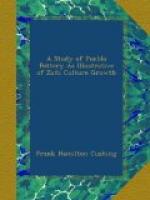[Illustration: FIG. 559.—Paintings of sacred butterfly.]
[Illustration: FIG. 560.—Painting of “summer-bird.”]
Happily, a work collateral to the one which I have here merely begun, will, I have reason to hope, be carried to a high degree of perfection in the forthcoming monographs on the exhaustless ceramic collections of the United States National Museum by Mr. William H. Holmes. This author and artist will approach his task from a standpoint differing from mine, reaching thereby, it may be, conclusions at variance with the foregoing; but by means of his wealth of material and illustration students will have opportunity of passing a judgment upon the merits of not only his work, but of my own.
[Illustration: FIG. 561.—Rectangular type of earthen vessel.]
In conclusion, let me very briefly refer to two distinctive American types of pottery, unconnected with the Southwestern, which, considered in conjunction with those of the latter region, seem to me to indicate that the ceramic art has had independent centers of origin in America. For the sake of convenience, I may name these types the rectangular (see Fig. 561) or Iroquois, and the bisymmetrical or kidney-shaped (see Fig. 562), of Nicaragua. The one is almost constant in the lake regions of the United States, the other equally constant in sections of Central America. In collections gathered from any tribe of our Algonquin or Iroquois Indians, one may observe vessels of the tough birch- or linden-bark, some of which are spherical or hemispherical. To produce this form of utensil from a single piece of bark, it is necessary to cut pieces out of the margin and fold it. Each fold, when stitched together in the shaping of the vessel, forms a corner at the upper part. (See Fig. 563.) These corners and the borders which they form are decorated with short lines and combinations of lines, composed of coarse embroideries with dyed porcupine quills. (See Fig. 564) May not the bark vessel have given rise to the rectangular type of pottery and its quill ornamentation to the incised straight-line decorations? (Compare Fig. 561.)
[Illustration: FIG. 562.—Kidney-shaped vessel, Nicaragua.]
[Illustration: FIG. 563.—Iroquois bark-vessel.]
So, too, in the unsymmetrical urns of Central and Isthmean America, which are characterized by the location of the aperture at the upper part of one of the extremities and by streak-like decorations, we have a decided suggestion of the animal paunch or bladder and of the visible veins on its surface when distended.
[Illustration: FIG. 564.—Porcupine quill decoration.]
If these conjectures be accepted as approximately correct, even in tendency, we may hope by a patient study of the ceramic remains of a people, no matter where situated, to discover what was the type of their pre-ceramic vessels, and thereby we might also learn whether, at the time of the origin of the potter’s art or during its development, they had, like the Pueblos, been indigenous to the areas in which they were found, or whether they had, like some of the Central Americans, (to make a concrete example and judge it by this method) apparently immigrated in part from desert North America, in part from the wilderness of an equatorial region in South America.




